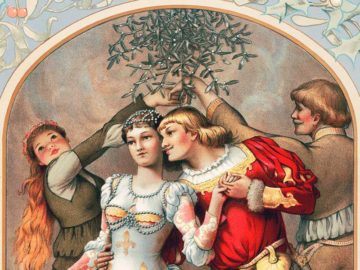Rachel Ehrenberg in Smithsonian:
 Some plants are so entwined with tradition that it’s impossible to think of one without the other. Mistletoe is such a plant. But set aside the kissing custom and you’ll find a hundred and one reasons to appreciate the berry-bearing parasite for its very own sake. David Watson certainly does. So enamored is the mistletoe researcher that his home in Australia brims with mistletoe-themed items including wood carvings, ceramics and antique French tiles that decorate the bathroom and his pizza oven. And plant evolution expert Daniel Nickrent does, too: He has spent much of his life studying parasitic plants and, at his Illinois residence, has inoculated several maples in his yard — and his neighbor’s — with mistletoes. But the plants that entrance these and other mistletoe aficionados go far beyond the few species that are pressed into service around the holidays: usually the European Viscum album and a couple of Phoradendron species in North America, with their familiar oval green leaves and small white berries. Worldwide, there are more than a thousand mistletoe species. They grow on every continent except Antarctica — in deserts and tropical rain forests, on coastal heathlands and oceanic islands. And researchers are still learning about how they evolved and the tricks they use to set up shop in plants from ferns and grasses to pine and eucalyptus.
Some plants are so entwined with tradition that it’s impossible to think of one without the other. Mistletoe is such a plant. But set aside the kissing custom and you’ll find a hundred and one reasons to appreciate the berry-bearing parasite for its very own sake. David Watson certainly does. So enamored is the mistletoe researcher that his home in Australia brims with mistletoe-themed items including wood carvings, ceramics and antique French tiles that decorate the bathroom and his pizza oven. And plant evolution expert Daniel Nickrent does, too: He has spent much of his life studying parasitic plants and, at his Illinois residence, has inoculated several maples in his yard — and his neighbor’s — with mistletoes. But the plants that entrance these and other mistletoe aficionados go far beyond the few species that are pressed into service around the holidays: usually the European Viscum album and a couple of Phoradendron species in North America, with their familiar oval green leaves and small white berries. Worldwide, there are more than a thousand mistletoe species. They grow on every continent except Antarctica — in deserts and tropical rain forests, on coastal heathlands and oceanic islands. And researchers are still learning about how they evolved and the tricks they use to set up shop in plants from ferns and grasses to pine and eucalyptus.
All of the species are parasites. Mistletoes glom on to the branches of their plant “hosts,” siphoning off water and nutrients to survive. They accomplish this thievery via a specialized structure that infiltrates host tissues. The familiar holiday species often infest stately trees such as oaks or poplar: In winter, when these trees are leafless, the parasites’ green, Truffula-like clumps are easy to spot dotting their host tree’s branches. Yet despite their parasitism, mistletoes may well be the Robin Hoods of plants. They provide food, shelter and hunting grounds for animals from birds to butterflies to mammals — even the occasional fish. Fallen mistletoe leaves release nutrients into the forest floor that would otherwise remain locked within trees, and this generosity ripples through the food chain.
More here.
